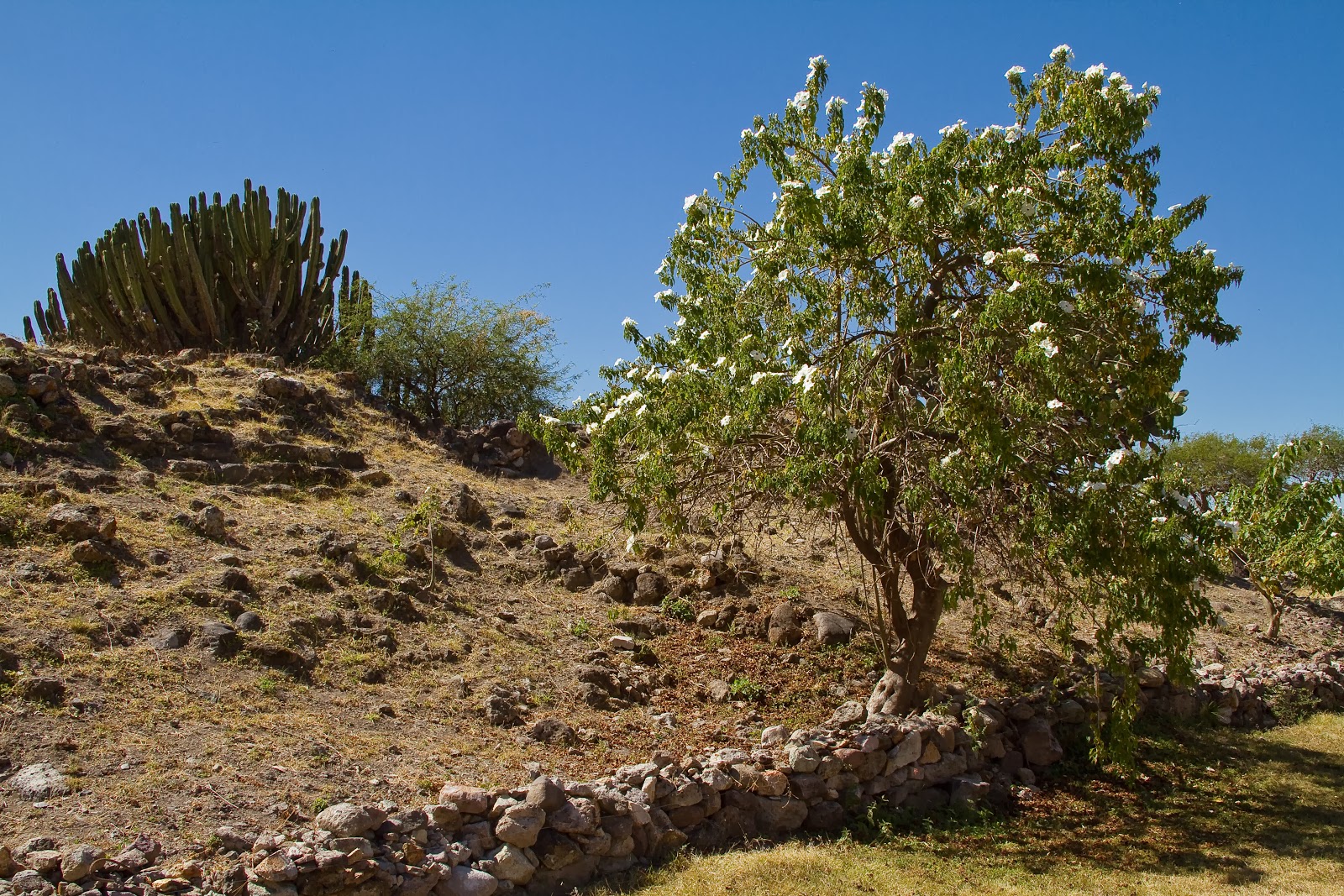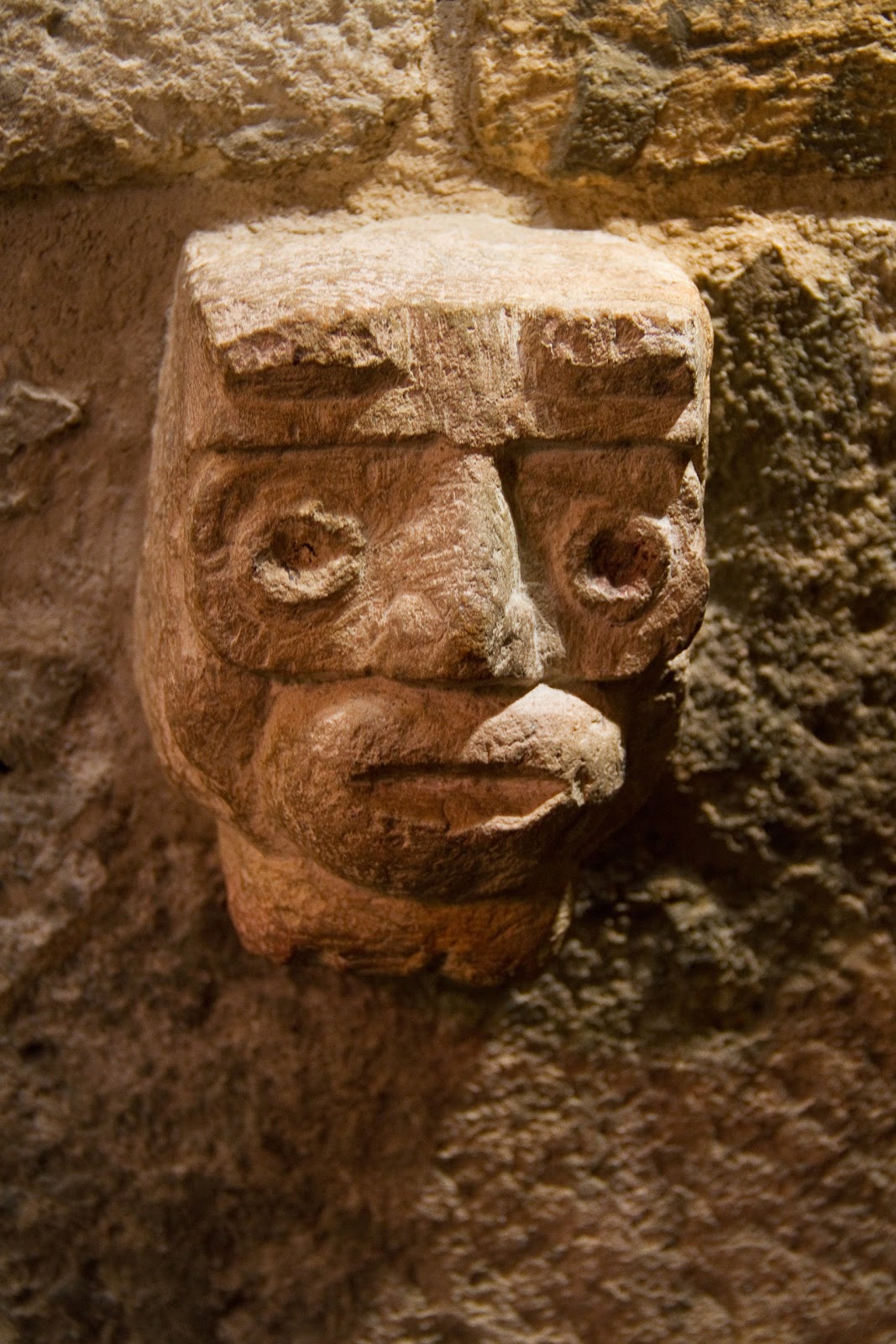El nombre de Yagul proviene de la lengua
zapoteca, se forma a partir de ya (árbol) y gul (edad), por lo tanto,
"viejo árbol". A sólo 10 km de
Mitla, Yagul comparte detalles arquitectónicos con Mitla, pero su magnitud y complejidad
sugiere que fue una ciudad independiente.
Los lugareños llaman la ruina "pueblo viejo" y recuerden que
como el precursor de la actual ciudad de Tlacolula. Yagual fue ocupada en el momento de la
conquista española, con una población de más de 6.000 personas. Después de la
conquista la población se trasladó a la moderna ciudad de Tlacolula, donde sus
descendientes aún viven.


The name Yagul comes from the Zapotec language,
it is formed from ya (tree) and gul (old), hence "old tree". Only 10 km from Mitla, Yagul shares
architectural details with Mitla but its size and complexity suggests that it
was an independent city. Locals call the
ruin ‘pueblo viejo’ and remember it as the forerunner of the present town of
Tlacolula. Yagual was occupied at the
time of the Spanish Conquest with a population of more than 6000 people. After the Conquest the population was
relocated to the modern town of Tlacolula where their descendants still live.
Yagul fue ocupada por primera vez alrededor
500-100 aC. Alrededor de 500-700 dC, las estructuras residenciales, civiles y
ceremoniales fueron construidos en el sitio. Sin embargo, la mayor parte de los
restos visibles datan de 1250-1521 dC, cuando el sitio funcionó como la capital
de una ciudad-estado del Posclásico.
Yagul was first occupied around 500-100 BC.
Around 500-700 AD, residential, civic and ceremonial structures were built at
the site. However, most of the visible remains date to 1250-1521 AD, when the
site functioned as the capital of a Postclassic city-state.
Yagul es uno de los sitios arqueológicos más
estudiados en el valle de Oaxaca. El sitio está construido alrededor de una
colina, y se puede dividir en tres áreas principales: la fortaleza, el centro
ceremonial y las zonas residenciales. Zonas
residenciales sin excavar se encuentran en terrazas al sur, al este y al oeste
de la colina. La piedra de construcción en Yagul es principalmente guijarros de
río formados a partir de rocas volcánicas como el basalto. Los vestigios de presencia humana en la zona,
a saber petroglifos en Caballito Blanco, fecha hasta al menos 3000 antes de
Cristo.

Yagul is one of the most studied archaeological
sites in the valley of Oaxaca. The site
is set around a hill, and can be divided into three principal areas: the
fortress, the ceremonial center and the residential areas. Unexcavated residential areas lie on terraces
to the south, east and west of the hill. The construction stone at Yagul is mainly
river cobbles formed from volcanic rock such as basalt. Vestiges of human habitation in the area,
namely petroglyphs at Caballito Blanco, date to at least 3000 BCE.


El sitio fue excavado en los años 1950 y 60, por
los arqueólogos Ignacio Bernal y John Paddock.
El centro ceremonial, excavado en 1974 por Bernal, compone la gran
mayoría de lo que se ve hoy en día. El centro ceremonial consta de una serie de
grandes patios bordeados de arquitectura monumental, y también incluye un juego
de pelota y un complejo residencial de élite.
El cancha de pelota restaurada es la más grande en el valle de Oaxaca.
Tiene una longitud total de 47 metros y una longitud de campo central de 30
metros, y se encuentra a 6 metros de ancho.


The site was excavated in the 1950s and 60s by
archaeologists Ignacio Bernal and John Paddock.
The ceremonial center, excavated in 1974 by Bernal, composes the vast
majority of what can be seen today. The
ceremonial center consists of a number of large patios bordered by monumental
architecture, and also includes a ball court and an elite residential complex. The restored ball court is the largest in the
valley of Oaxaca. It has a total length of 47 meters and a central field length
of 30 meters, and is 6 meters wide.
El complejo residencial conocido como el palacio
de los seis patios es una estructura laberíntica formada por tres complejos de
élite, cada uno con dos patios rodeados de habitaciones. Una entrada de la
tumba se encuentra en cada patio. Las paredes se enfrentan con piedras labradas
y estuco sobre un núcleo de piedra y arcilla. Los suelos eran de estuco rojo.
The residential complex known as the palace of
the six patios is a labyrinthine structure formed of three elite complexes,
each with two patios surrounded by rooms. A tomb entrance is found in each patio. The
walls are faced with dressed stones and stucco over a stone and clay core. The floors were of red stucco.
 |
| Patio 4 with a jaguar figure under the cover |
 Patio 4 se encuentra al sureste de la cancha de
pelota y es parte de un complejo de templos-patio-altar formado a partir de
cuatro montículos alrededor de un altar central. Una escultura de un jaguar-efigie se
encuentra en la base del montículo oriental. Es posible entrar en la tumba 30
debajo del patio 4. Está formado de tres cámaras con paneles decorados. La
cámara principal tiene una fachada decorada con dos cabezas humanas talladas en
piedra. La puerta de la tumba es una losa de piedra con inscripciones
jeroglíficas en ambos lados. Unas 30 tumbas se han encontrado en Yagul. Usted puede subir una colina desde donde se
puede obtener una buena visión general de Yagul.
Patio 4 se encuentra al sureste de la cancha de
pelota y es parte de un complejo de templos-patio-altar formado a partir de
cuatro montículos alrededor de un altar central. Una escultura de un jaguar-efigie se
encuentra en la base del montículo oriental. Es posible entrar en la tumba 30
debajo del patio 4. Está formado de tres cámaras con paneles decorados. La
cámara principal tiene una fachada decorada con dos cabezas humanas talladas en
piedra. La puerta de la tumba es una losa de piedra con inscripciones
jeroglíficas en ambos lados. Unas 30 tumbas se han encontrado en Yagul. Usted puede subir una colina desde donde se
puede obtener una buena visión general de Yagul.


 Patio 4 lies to the southeast of the ball court
and is part of a temple-patio-altar complex formed from four mounds around a
central altar. A sculpture of a jaguar-effigy lies at the base of the eastern
mound. It is possible to enter tomb 30
underneath patio 4. It is formed of
three chambers with decorated panels. The
principal chamber has a facade decorated with two human heads carved in stone. The door to the tomb is a stone slab with
hieroglyphic inscriptions on both sides. About 30 tombs have been found at Yagul. You can walk up a the hill from which one can
get a good overview of Yagul. For more pictures please go to my web album.
Patio 4 lies to the southeast of the ball court
and is part of a temple-patio-altar complex formed from four mounds around a
central altar. A sculpture of a jaguar-effigy lies at the base of the eastern
mound. It is possible to enter tomb 30
underneath patio 4. It is formed of
three chambers with decorated panels. The
principal chamber has a facade decorated with two human heads carved in stone. The door to the tomb is a stone slab with
hieroglyphic inscriptions on both sides. About 30 tombs have been found at Yagul. You can walk up a the hill from which one can
get a good overview of Yagul. For more pictures please go to my web album.
For more information in English visit:




















































